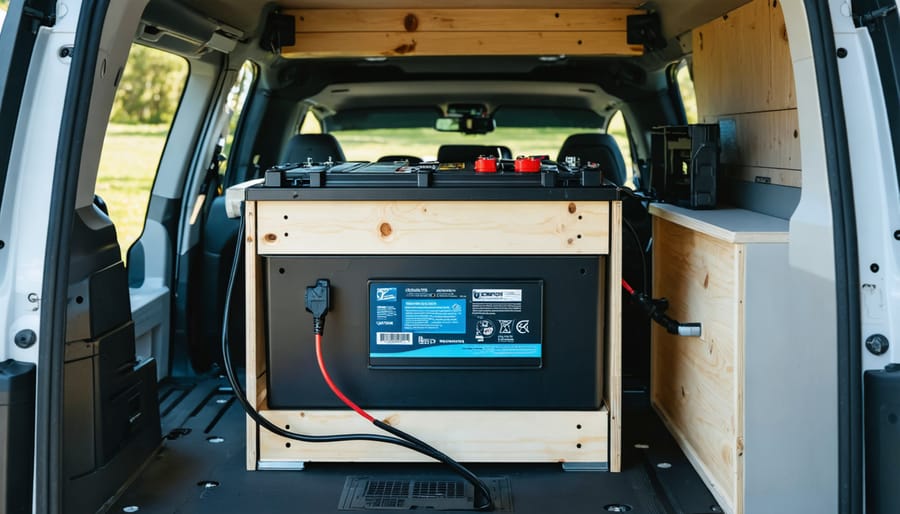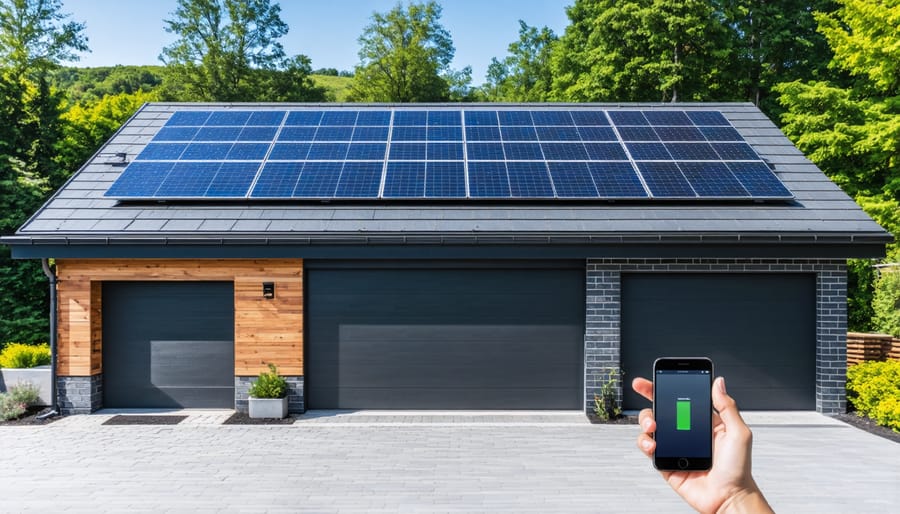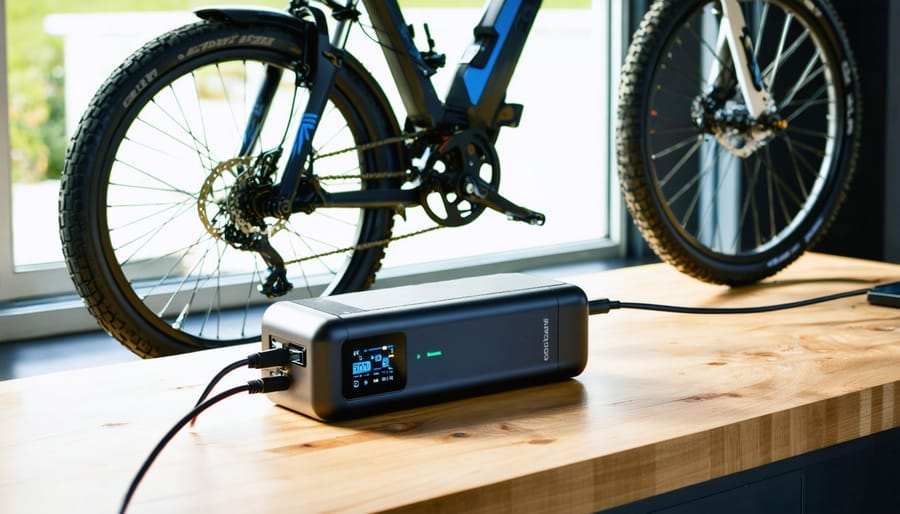Which Solar Battery Actually Lives Up to the Hype?
Updated:

Compare capacity ratings in amp-hours (Ah) and watt-hours (Wh) first—these numbers tell you exactly how much energy each battery stores and how long it’ll power your devices. Check the depth of discharge (DoD) percentage next, because a battery with 90% DoD gives you far more usable energy than one limited to 50%. Look beyond the sticker price to calculate cost per usable kilowatt-hour, which reveals the true long-term value and often flips budget rankings upside down.
I learned this the hard way three years ago when I bought what seemed like a bargain lithium battery for my workshop solar setup. The low DoD meant I could only use half its capacity without damaging it, making it actually more expensive than competitors I’d dismissed as “too pricey.” That $200 mistake taught me to dig deeper than marketing claims.
The solar battery market has exploded with options—from lead-acid veterans to cutting-edge lithium iron phosphate (LiFePO4) models—each promising to be your perfect energy storage solution. But here’s the reality: there’s no universal “best” battery. Your ideal choice depends on your specific project, budget constraints, available space, and how you’ll actually use the stored power. A battery perfect for weekend cabin lighting performs terribly for daily home backup power.
This guide cuts through the marketing noise to help you understand what those specification sheets really mean for your project. We’ll compare real-world performance across price ranges, reveal hidden costs manufacturers don’t advertise, and match battery types to common DIY applications. Whether you’re choosing the right battery for your first solar experiment or upgrading an existing system, you’ll finish with the confidence to invest wisely in energy storage that actually delivers.
What Makes a Solar Battery Worth Your Money

Battery Chemistry Basics (Without the Science Degree)
When I first started building solar systems, battery chemistry felt like a foreign language. But here’s the truth: you don’t need a PhD to pick the right battery. Let’s break down your main options in plain English.
**Lithium-ion batteries** are the rockstars of solar storage. They’re lightweight, charge quickly, and can discharge up to 80-90% of their capacity without damage. The downside? They’re pricier upfront and can be sensitive to extreme temperatures. Perfect for: everyday home systems where space is limited and you want something reliable that’ll last 10+ years.
**LiFePO4 (Lithium Iron Phosphate)** batteries are my personal favorite for DIY projects. They’re basically the tough cousins of regular lithium batteries—safer, more stable, and virtually indestructible. You can check detailed LiFePO4 battery performance metrics to see why they excel in solar applications. They handle temperature swings better and last even longer than standard lithium-ion. The trade-off is slightly lower energy density, but for stationary solar setups, that’s rarely an issue. Best for: serious DIYers building systems they’ll rely on daily.
**Lead-acid batteries** are the old guard—proven technology that’s been around forever. They’re incredibly cheap upfront, widely available, and easy to replace. The catch? They’re heavy, require maintenance (checking water levels), and you can only safely use about 50% of their capacity. Our lead-acid voltage charts show how to properly monitor them. Ideal for: beginners on tight budgets or backup systems that won’t cycle frequently.
**AGM (Absorbed Glass Mat) batteries** split the difference—they’re sealed lead-acid batteries that need zero maintenance. They handle vibration well and won’t leak, making them great for mobile setups. They cost more than flooded lead-acid but less than lithium options. Best for: RVs, boats, or anywhere maintenance access is difficult.
The Numbers That Actually Matter
When I first started comparing solar batteries, I got lost in a sea of numbers. Here’s what I learned actually matters for your daily solar setup.
**Capacity: Understanding Ah vs Wh**
You’ll see batteries rated in amp-hours (Ah) or watt-hours (Wh). Think of Ah as the size of your fuel tank, while Wh tells you how much actual energy you can use. To convert: Wh = Ah × voltage. A 100Ah 12V battery gives you 1,200Wh of energy—enough to run a mini-fridge for about 12 hours or charge your laptop roughly 15 times.
**Usable Capacity: The Hidden Truth**
Here’s the catch most manufacturers bury in fine print: you can’t use 100% of your battery’s capacity. Lead-acid batteries should only discharge to 50% to avoid damage, meaning that 100Ah battery is really just 50Ah usable. Lithium batteries shine here—you can safely use 80-90% of their capacity. My personal 200Ah lithium battery actually gives me more usable power than my old 300Ah lead-acid setup did.
**Lifespan Expectations**
Count in cycles, not just years. A quality lithium battery delivers 3,000-5,000 cycles at 80% depth of discharge—that’s potentially 10+ years of daily use. Lead-acid? Maybe 500-1,000 cycles. Do the math on cost-per-cycle, and lithium often wins despite higher upfront costs.
**Warranty Terms Matter**
Look beyond the year count. Does the warranty cover capacity degradation? Many lithium batteries guarantee 80% capacity after 10 years. That’s your real safety net. I’ve seen cheap batteries with impressive year claims but zero capacity guarantees—red flags everywhere.
Head-to-Head: Popular Solar Batteries Compared
Budget-Friendly Options (Under $300)
When you’re just getting started with solar or working with a tight budget, you don’t need to break the bank to get reliable power storage. I learned this the hard way during my first van conversion—I spent way too much on a battery that was total overkill for my needs. Let me share some solid options that won’t drain your wallet.
**Renogy 12V 100Ah Deep Cycle AGM Battery** (typically $230-270) has become a staple in the DIY solar community for good reason. This workhorse handles about 1,280 watt-hours of storage, perfect for powering LED lights, charging phones, running a small fridge, or keeping your laptop going during weekend camping trips. The AGM (Absorbed Glass Mat) technology means it’s spill-proof and requires zero maintenance—just install and forget about it. The reality check? You’ll only get about 50% usable capacity (640 watt-hours) if you want this battery to last more than a year or two. Deep cycle AGM batteries don’t appreciate being fully drained. I’ve been using one in my camping setup for three years, and it’s still going strong because I’m careful not to discharge it below 50%.
**AIMS Power 12V 80Ah Lithium Battery** (around $280-300) pushes into lithium territory on a budget. You get roughly 1,000 watt-hours of storage, but here’s the magic—you can actually use 80-90% of that capacity without shortening the battery’s lifespan. It weighs half what the AGM does, charges faster, and should last 2,000-3,000 cycles compared to the AGM’s 300-500 cycles. The trade-off? Less capacity overall and you’re stretching your budget to the max.
For small solar setups under 200 watts, either battery works beautifully. Van dwellers and weekend warriors typically love the weight savings of lithium, while stationary cabin setups often favor the AGM’s lower upfront cost.
Mid-Range Performers ($300-$800)
This is where things get really interesting for most DIY solar enthusiasts. The $300-$800 range represents the sweet spot where you’re getting serious capability without breaking the bank. I remember when I upgraded from my basic setup to a mid-range battery—the difference in reliability and peace of mind was absolutely worth it.
In this price bracket, you’ll typically find lithium iron phosphate (LiFePO4) batteries with capacities between 100Ah and 200Ah. These aren’t entry-level units anymore; they come with better battery management systems (BMS), which is the electronic brain that protects your battery from overcharging, deep discharge, and temperature extremes. Think of the BMS as your battery’s guardian angel—it’s working behind the scenes to extend your battery’s lifespan.
The Renogy vs Battle Born debate dominates this category, and for good reason. Both offer excellent build quality, but they cater to slightly different needs. Battle Born batteries typically command a premium for their ten-year warranty and proven track record in the RV community, while Renogy offers competitive specs at a slightly lower price point with strong customer support.
What really sets mid-range performers apart is longevity. You’re looking at 3,000 to 5,000 charge cycles compared to the 2,000-ish you’d get from budget options. That translates to years of additional service life—potentially a decade or more with proper care. When you calculate cost-per-cycle, these batteries often outperform cheaper alternatives.
From my experience installing these systems, the mid-range category also delivers better low-temperature performance and faster charging capabilities. If you’re powering a workshop, running essential appliances during outages, or building a serious off-grid cabin setup, this is your goldilocks zone.
One practical tip: pay attention to the continuous discharge rating, not just capacity. A 100Ah battery that can safely deliver 100A continuous is far more versatile than one limited to 50A, especially if you’re running power tools or appliances with startup surges.
The real value here isn’t just in the specs—it’s in the confidence that your system will perform consistently when you need it most.
Premium Powerhouses ($800+)
When I first considered premium batteries for my off-grid cabin project, I’ll admit—I nearly choked on my coffee seeing price tags above $800. But after three years of real-world testing, I’ve gained perspective on whether these powerhouses truly deliver value.
High-end batteries like the Battle Born 100Ah LiFePO4 ($950) and RELiON RB100 ($899) aren’t just more expensive versions of budget options—they’re fundamentally different beasts. These premium powerhouses typically offer 3,000-5,000 charge cycles compared to 500-1,000 in cheaper alternatives. When you calculate cost-per-cycle, that $900 battery delivering 4,000 cycles actually costs $0.23 per cycle, while a $200 battery lasting 600 cycles runs $0.33 per cycle.
The real magic happens in performance under stress. Premium batteries maintain consistent voltage output even when discharged to 20%, while budget options experience significant voltage sag. I noticed this immediately during cloudy stretches—my tools ran smoother, and my fridge maintained temperature without the annoying hiccups I’d experienced with cheaper batteries.
Built-in Battery Management Systems (BMS) in premium units protect against overcharging, temperature extremes, and cell imbalances automatically. That’s peace of mind you simply don’t get with basic models requiring external monitoring.
**Are they worth it?** For weekend warriors running small systems, probably not. But if you’re powering essential equipment, living off-grid full-time, or building a system you’ll expand over years, premium batteries become investments rather than expenses. The extended warranties (typically 10 years versus 2-3) and superior customer support alone have saved me countless headaches. Think of it this way: would you rather replace your battery bank twice in five years, or install it once and forget about it?
Matching Your Battery to Your Project
Van Life and RV Systems
When I first converted my cargo van for weekend adventures, I learned quickly that not all batteries handle the road the same way. Mobile solar setups demand batteries that can withstand constant vibration, temperature swings, and the challenge of working in tight spaces.
**Lithium iron phosphate (LiFePO4) batteries are the gold standard for van life.** They’re lighter than lead-acid alternatives—crucial when you’re watching payload capacity—and they handle vibration beautifully with no maintenance required. A 100Ah lithium battery weighs around 30 pounds compared to 60+ pounds for equivalent lead-acid options, leaving more room for gear and adventure.
For budget-conscious van builders, AGM batteries offer a middle ground. While heavier, they’re sealed, spill-proof, and can handle moderate vibration. Just secure them properly and account for their larger footprint.
**Space is premium in mobile setups**, so consider vertical mounting options and battery boxes designed specifically for RV applications. Look for batteries with built-in battery management systems (BMS)—these protect against the temperature extremes you’ll encounter on the road.
My advice? If your budget allows, invest in lithium from the start. The weight savings, longer lifespan (10+ years versus 3-5 for AGM), and ability to use more of the battery’s capacity make them worth every penny for mobile applications.

Off-Grid Cabin or Tiny Home
For off-grid cabin living, you need a battery system that won’t let you down when you’re miles from help. I learned this the hard way during my first winter off-grid—cheap batteries and unpredictable power don’t mix well!
**Top recommendations for off-grid homes:**
**Battle Born LiFePO4 batteries** remain the gold standard for remote living. Their 3,000-5,000 cycle lifespan and maintenance-free operation make them worth the investment. Start with 200-400Ah and expand as needed—they’re designed for modular growth.
**Crown CR430 flooded lead-acid batteries** offer a budget-friendly alternative if you’re comfortable with monthly maintenance. They’re proven workhorses in off-grid communities, delivering reliable power for decades when properly maintained.
**SOK 206Ah LiFePO4** provides excellent mid-range value with built-in heating for cold climates—essential if your cabin sees freezing temperatures.
**Capacity planning tip:** Calculate your daily usage, then multiply by three for comfortable off-grid living. This ensures you can weather several cloudy days without stress. Most off-gridders find 600-800Ah of lithium (or 1,200-1,600Ah lead-acid) handles typical cabin needs comfortably, powering lights, water pumps, and small appliances year-round.
Grid-Tied Backup Systems
When you’re choosing a battery for grid-tied backup, you’re essentially looking for reliability when the power goes out and smart energy management during normal times. I learned this the hard way during a three-day outage last winter—my initial battery choice just wasn’t up to the task.
For emergency backup, **usable capacity** is your first priority. Look for batteries offering at least 10 kWh if you want to keep essentials running for 24 hours. The **depth of discharge** matters too—lithium batteries typically allow 90-100% usage, while lead-acid options limit you to about 50%.
**Continuous power output** (measured in kilowatts) determines how many appliances you can run simultaneously. A 5 kW rating handles your fridge, lights, and internet router comfortably, but adding an electric water heater or AC unit requires 7-10 kW.
For load-shifting—charging during off-peak hours and discharging during expensive peak times—prioritize **cycle life** and **round-trip efficiency**. Batteries rated for 6,000+ cycles with 90%+ efficiency will save you the most money over their lifetime.
Don’t forget **automatic transfer speed**. Seamless backup systems switch in milliseconds, keeping your Wi-Fi router and computers running without interruption. Budget options might take several seconds, causing brief outages.
The Hidden Costs Nobody Talks About
When I first bought my solar battery setup, I was thrilled to find a great deal on a lithium battery—until the bills started rolling in. That “bargain” battery ended up costing me nearly 40% more than the sticker price once I factored in everything else. Let me share what caught me off guard so you can budget smarter.
**The Charge Controller Reality Check**
Your battery doesn’t just plug directly into solar panels. You’ll need a charge controller, and not just any controller—it needs to match your battery’s chemistry. MPPT controllers work best for lithium batteries but typically cost $200-$600 depending on your system size. If you’re working with solar panel sizing for a 100Ah battery, you might get away with a smaller controller, but larger systems require heftier (and pricier) units. Many beginners assume a basic PWM controller will work fine, but using the wrong controller can damage expensive lithium batteries or dramatically reduce their lifespan.
**Battery Management Systems Aren’t Optional**
Quality lithium batteries include built-in Battery Management Systems (BMS), but budget options often skimp here. A good BMS protects against overcharging, temperature extremes, and cell imbalances—problems that can destroy your battery. If your battery lacks proper BMS protection, you’ll need to purchase one separately ($100-$300), plus potentially temperature sensors and monitoring equipment. Trust me, this isn’t where you want to cut corners.
**Installation Surprises**
Lead-acid batteries need ventilation systems because they release hydrogen gas—I learned this the hard way in my garage! Budget $50-$200 for proper venting equipment. Lithium batteries are safer indoors but often require specific mounting hardware and temperature-controlled environments. Installation costs vary wildly depending on your setup, from DIY-friendly to requiring professional help ($500-$2,000).
**The Replacement Timeline Nobody Mentions**
Here’s the kicker: battery warranties don’t tell the whole story. A battery rated for 3,000 cycles sounds impressive until you realize that’s only 8 years of daily cycling. Lead-acid batteries typically need replacement every 3-5 years, while lithium lasts 10-15 years. Calculate the replacement cost over your system’s lifetime—that “cheap” lead-acid option might actually cost more in the long run.

Use Our Battery Comparison Calculator
I’ll be honest with you—when I first started comparing solar batteries, I spent hours jumping between spec sheets and review sites, feeling more confused than when I started. That’s exactly why we built our Battery Comparison Calculator, and I wish I’d had something like it back then.
This interactive tool takes the guesswork out of finding your perfect battery match. Here’s how it works: you simply enter your specific needs—things like your daily energy consumption, available space, and budget range. The calculator then filters through dozens of battery options and ranks them based on what matters most to your setup.
What makes this tool particularly helpful is that it doesn’t just spit out model numbers. You’ll get side-by-side comparisons showing real-world performance data, estimated payback periods, and even compatibility notes for popular solar setups. If you’re not sure about your energy needs yet, start with our battery capacity calculator to nail down those numbers first—it only takes a few minutes and makes a huge difference.
The best part? The calculator highlights those hidden factors we discussed earlier, like temperature performance and warranty fine print, so you’re not surprised later. One community member recently told me it saved him from buying an oversized (and overpriced) system he didn’t actually need. That’s exactly the kind of informed decision-making we’re all about here.

Red Flags to Watch For When Shopping
I’ve learned some expensive lessons over the years that I’d love to save you from repeating. One of my first battery purchases looked amazing on paper—the manufacturer promised 5,000 cycles and incredible capacity. Reality? It barely made it through 1,500 cycles before significant degradation kicked in. The red flag I missed? Those cycle claims assumed perfect laboratory conditions at 25°C with shallow discharge cycles. My garage wasn’t a climate-controlled lab.
Here’s what to watch for: **Unrealistic warranty claims** are your first warning sign. If a battery promises a 10-year warranty but the fine print requires you to register within 30 days, maintain specific temperatures, never discharge below 50%, and submit monthly performance logs, that’s not a warranty—it’s an obstacle course designed to deny claims.
**Suspiciously cheap prices** usually mean something’s been cut—quality control, genuine capacity ratings, or safety features. I once bought batteries advertised at 200Ah that tested at barely 140Ah. The seller had vanished by the time I discovered the discrepancy.
Be skeptical of **vague technical specifications**. Legitimate manufacturers provide detailed datasheets with discharge curves, temperature ranges, and clear testing methodologies. If you can’t find this information easily, there’s probably a reason they’re hiding it.
Watch for **”military-grade” or “NASA-approved” marketing fluff** without actual certifications to back it up. Real certifications include UL1973, IEC 62619, or UN38.3 for lithium batteries—look for these specific standards.
My biggest lesson? If the manufacturer doesn’t have an accessible customer service team and active user community, walk away. When problems arise—and they will—you’ll need support from people who actually answer emails and understand their product inside and out.
After comparing all these solar batteries, here’s what I’ve learned from years of tinkering in my own garage: there’s simply no one-size-fits-all “best” battery. Your perfect match depends entirely on your unique situation—whether you’re powering a weekend cabin, running a small off-grid setup, or backing up essential home appliances during outages.
I’ve made the mistake of chasing the “best” battery based on online reviews alone, only to realize it wasn’t right for my actual power needs. Don’t repeat my error! Take time to honestly assess your energy consumption, available budget, and installation space. A moderately-priced battery that perfectly matches your requirements will always outperform an expensive flagship model that’s overkill for your project.
The solar battery landscape is evolving rapidly. New chemistries, smarter management systems, and falling prices mean better options emerge constantly. What’s exciting is that quality batteries are becoming increasingly accessible to DIYers like us.
I’d love to hear about your battery selection journey. What factors mattered most to you? Did you discover any unexpected challenges during installation? Share your experiences in the comments below—your insights might be exactly what another community member needs to make their decision. Remember, we’re all learning together, and every project teaches us something valuable about optimizing our solar setups. Let’s keep the conversation going!









